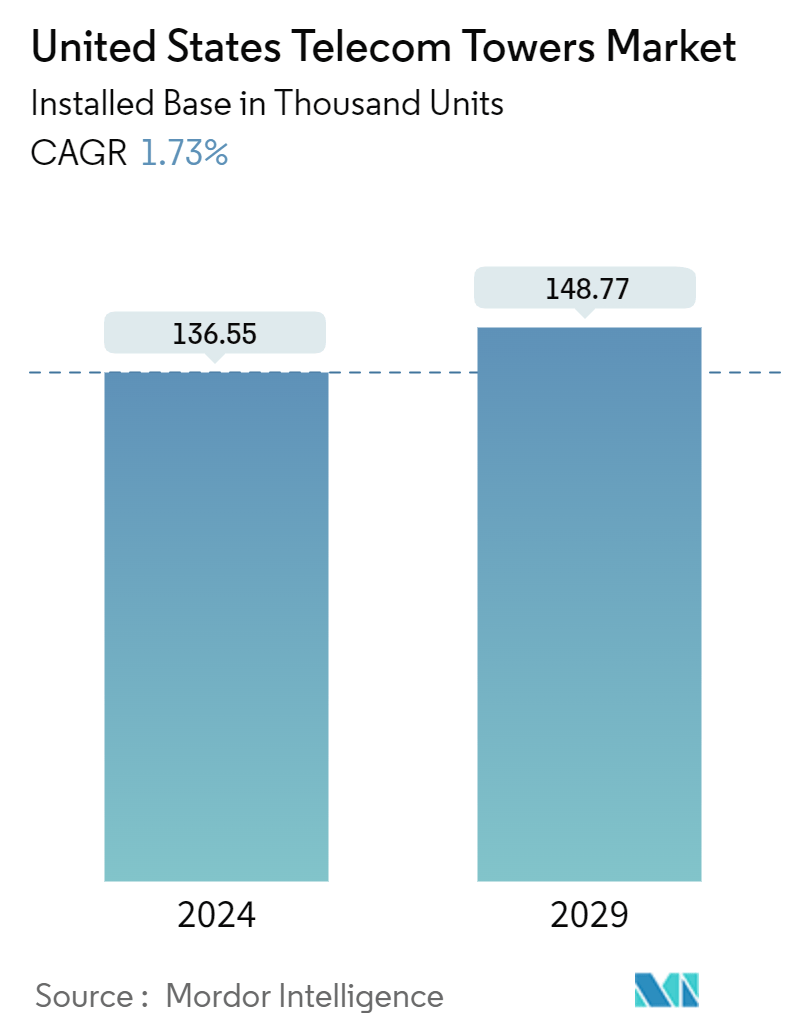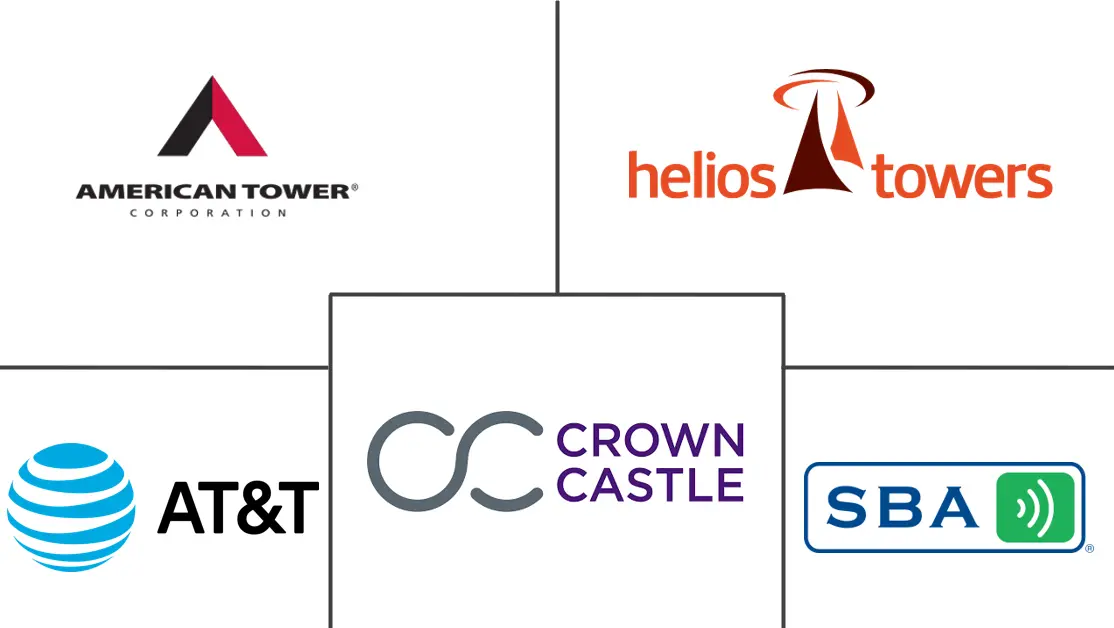Market Size of United States Telecom Towers Industry

| Study Period | 2019 - 2029 |
| Base Year For Estimation | 2023 |
| Market Volume (2024) | 136.55 Thousand units |
| Market Volume (2029) | 148.77 Thousand units |
| CAGR (2024 - 2029) | 1.73 % |
| Market Concentration | High |
Major Players
*Disclaimer: Major Players sorted in no particular order |
US Telecom Towers Market Analysis
The United States Telecom Towers Market size in terms of installed base is expected to grow from 136.55 Thousand units in 2024 to 148.77 Thousand units by 2029, at a CAGR of 1.73% during the forecast period (2024-2029).
The United States telecom tower market plays a crucial role in supporting the nation’s rapidly growing demand for reliable wireless communication. With the rise of mobile devices, data consumption, and next-generation technologies like 5G, telecom towers have become essential to the country's digital infrastructure. The market includes a variety of stakeholders, including telecom tower companies, mobile network operators, and wireless infrastructure providers, all working together to enhance the country's network capacity.
Regulatory Landscape of Telecom Towers in the U.S.:
The regulation of telecommunication towers is a significant aspect of the U.S. market. Federal, state, and local regulations govern tower deployment, maintenance, and environmental compliance. The Federal Communications Commission (FCC) sets many of these guidelines, impacting everything from site approval to spectrum allocation. Compliance with environmental concerns, such as radiation limits and power supply sustainability, is critical, influencing both the design and placement of towers.
- FCC Guidelines: The FCC’s regulatory framework plays a central role in how telecom tower infrastructure grows, influencing areas such as spectrum allocation and site licensing.
- Environmental Impact: Regulations also ensure that telecom towers meet environmental compliance standards, with emphasis on reducing radiation and promoting sustainability.
- Local Regulations: State and municipal bodies provide additional regulatory oversight, affecting the pace of telecom tower deployment across regions.
- Rural Deployment Policies: There is a growing regulatory focus on rural tower deployment to ensure coverage expansion into underserved areas.
Telecom Tower Infrastructure Growth in the U.S.:
Telecom tower infrastructure growth in the U.S. has accelerated due to the rising need for network expansion. As urban and rural areas alike increase their reliance on mobile communication, telecom companies are investing heavily in both ground-based and rooftop installations.
- Network Expansion: Increased mobile and data usage in both urban and rural regions is driving extensive investments in ground-based and rooftop towers.
- Private Ownership and Joint Ventures: Many telecom towers are owned by private firms, mobile operators, or through joint ventures. These partnerships facilitate rapid network growth.
- Tower Sharing: To minimize costs and expedite network rollout, telecom companies increasingly rely on tower-sharing agreements, reducing both environmental impact and infrastructure costs.
- Impact of COVID-19: The pandemic shifted network usage patterns, increasing the importance of reliable rural telecom towers, as companies adjusted strategies to meet surging demand in underserved areas.
U.S. 5G Rollout as a Catalyst for Expansion
The rapid deployment of 5G technology is driving significant demand for telecom tower infrastructure growth in the U.S. The fifth-generation mobile network promises faster speeds, lower latency, and higher capacity, all of which require more densely deployed telecom towers.
- 5G Infrastructure Growth: Telecom tower infrastructure growth in the USA is accelerating with the rollout of 5G technology, which demands extensive upgrades to macro towers and small cells.
- Small Cell Deployment: Beyond macro towers, small cell deployment is becoming essential, particularly in densely populated urban areas. These smaller units are often installed on streetlights and buildings, helping enhance network coverage.
- Rural 5G Expansion: In rural areas, extending 5G telecom towers is crucial for bridging the digital divide, though challenging due to lower population density and higher installation costs.
- Tower Leasing: The evolving model of telecom tower leasing in the USA allows telecom companies to focus on their core activities while renting infrastructure from tower operators, further driving market demand.
Environmental Concerns in Power Supply and Tower-sharing
The U.S. telecom tower market faces growing environmental challenges, particularly related to power supply systems. With the rising pressure to transition toward sustainable energy, telecom tower operators are increasingly exploring renewable energy sources for powering their infrastructure.
- Renewable Energy Integration: Telecom tower companies are adopting solar and wind energy solutions, especially in remote areas where traditional grid access is limited, thus reducing reliance on diesel generators.
- Environmental Sustainability Goals: Telecom firms are increasingly focused on reducing their carbon footprints, investing in green energy solutions, and upgrading existing infrastructure to support renewable power sources.
- Tower-sharing as an Environmental Strategy: Sharing towers between telecom providers reduces the environmental impact of building new towers, particularly in urban settings where infrastructure overlaps.
- Challenges in Tower-sharing: While sharing towers can reduce environmental footprints, it raises concerns about competitive advantages, with some larger telecom companies hesitant to share their assets.
US Telecom Towers Industry Segmentation
A Telecommunication Tower refers to various types of towers such as monopoles, tripoles, lattice towers, guyed towers, self-support towers, poles, masts, or similar structures. These towers are utilized to hold one or more telecommunication antennae for radio communications. They can be situated on the ground or on a building's roof, and may also have an equipment shelter with electronic devices. These towers do not have full-time staff and only need occasional maintenance.
The study tracks the telecom tower landscape in terms of tower count, ownership type, and type of energy source in the US. In addition to the key market metrics, we will also cover the trends related to the following: telecom tower climber demographics in the US; coverage of the role of turf vendors and the specific programs commissioned by the network providers; and key regulations and controls put in place to mitigate the environmental and safety regulatory landscape. The report also covers the impact of COVID-19 on the market.
The United States telecom towers market is segmented by fuel type (renewable, non-renewable), by installation (rooftop, ground-based), and by ownership (operator-owned, JV, private-owned, MNO captive). The market sizes and forecasts are provided in terms of installed base (unit) for all the above segments.
| By Fuel Type | |
| Renewable | |
| Non-renewable |
| By Installation | |
| Rooftop | |
| Ground-based |
| By Ownership | |
| Operator-owned | |
| Joint Venture | |
| Private-owned | |
| MNO Captive |
United States Telecom Towers Market Size Summary
The US telecom towers market is experiencing significant growth, driven by the increasing demand for high-speed internet and mobile connectivity. The shift towards remote work and digital communication has led to a surge in network traffic, necessitating the expansion and enhancement of telecom infrastructure. This evolution is supported by the development of TowerCos, which focus on building, purchasing, and leasing vertical real estate to accommodate the growing need for 5G antennae. The market is further bolstered by initiatives aimed at improving internet access in rural areas, as well as the adoption of mobile-centric business models like BYOD, which require robust network capabilities. Despite challenges such as delays in network equipment production, the market remains competitive, with major players like American Tower Corporation, Crown Castle, and SBA Communications leading the charge in expanding their infrastructure and services.
The market landscape is characterized by a high level of consolidation, with a few key players dominating the scene. These companies are not only expanding their presence in the US but also venturing into international markets to enhance their market share and profitability. Strategic acquisitions and partnerships, such as American Tower's acquisition of InSite Wireless Group and Crown Castle's collaboration with T-Mobile, are pivotal in driving growth and expanding network coverage. Additionally, there is a growing emphasis on sustainability, with companies like Helios Towers investing in renewable energy solutions to reduce their carbon footprint. As the demand for 5G networks continues to rise, significant investments are expected in the coming years, further propelling the market's expansion.
United States Telecom Towers Market Size - Table of Contents
-
1. MARKET INSIGHTS
-
1.1 United States Telecom Towers Market Overview
-
1.2 United States Regulation of Telecommunication Towers
-
1.3 Industry Attractiveness - Porter's Five Forces Analysis
-
1.3.1 Bargaining Power of Suppliers
-
1.3.2 Bargaining Power of Consumers
-
1.3.3 Threat of New Entrants
-
1.3.4 Threat of Substitutes
-
1.3.5 Intensity of Competitive Rivalry
-
-
1.4 Assessment of the impact of COVID-19 on the Telecom Tower landscape in the United States
-
1.5 Market Drivers
-
1.5.1 5G Deployments are a Major Catalyst for Growth in the Cell-tower Leasing Environment
-
-
1.6 Market Challenges
-
1.6.1 Environmental Concerns about Power Supply Systems to Towers and Tower-sharing between Telecom Companies
-
-
1.7 Tower Climber Landscape in the United States
-
-
2. MARKET SEGMENTATION
-
2.1 By Fuel Type
-
2.1.1 Renewable
-
2.1.2 Non-renewable
-
-
2.2 By Installation
-
2.2.1 Rooftop
-
2.2.2 Ground-based
-
-
2.3 By Ownership
-
2.3.1 Operator-owned
-
2.3.2 Joint Venture
-
2.3.3 Private-owned
-
2.3.4 MNO Captive
-
-
United States Telecom Towers Market Size FAQs
How big is the United States Telecom Towers Market?
The United States Telecom Towers Market size is expected to reach 136.55 thousand units in 2024 and grow at a CAGR of 1.73% to reach 148.77 thousand units by 2029.
What is the current United States Telecom Towers Market size?
In 2024, the United States Telecom Towers Market size is expected to reach 136.55 thousand units.

